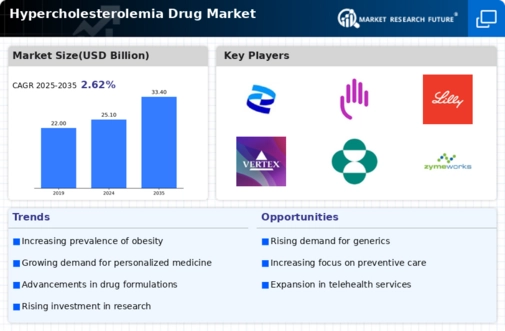Rising Awareness and Education
The growing awareness and education surrounding hypercholesterolemia are pivotal in shaping the Hypercholesterolemia Drug Market. Public health campaigns and educational initiatives have significantly increased knowledge about the dangers of high cholesterol and the importance of managing it. This heightened awareness encourages individuals to seek medical advice and treatment options, thereby driving demand for cholesterol-lowering medications. Surveys indicate that a substantial percentage of the population is now more informed about cholesterol levels and their implications for heart health. As a result, healthcare providers are likely to see an uptick in patients requesting cholesterol screenings and subsequent pharmacological interventions. This trend not only benefits patients but also stimulates market growth as pharmaceutical companies respond to the increasing demand for effective treatments.
Advancements in Drug Development
Innovations in drug development are significantly influencing the Hypercholesterolemia Drug Market. The emergence of novel therapeutic agents, such as PCSK9 inhibitors and bempedoic acid, has transformed treatment paradigms. These advancements not only offer improved efficacy but also provide alternatives for patients who are intolerant to traditional statin therapies. The market for these new drugs is projected to expand, with estimates suggesting a compound annual growth rate of over 10% in the coming years. Additionally, the ongoing research into combination therapies may further enhance treatment outcomes, thereby attracting more patients to seek pharmacological solutions. As a result, pharmaceutical companies are likely to prioritize the development of innovative drugs that can cater to diverse patient needs, thereby driving market growth.
Increasing Healthcare Expenditure
Rising healthcare expenditure is a crucial factor propelling the Hypercholesterolemia Drug Market. As countries allocate more resources to healthcare, there is a corresponding increase in spending on medications for chronic conditions, including hypercholesterolemia. Reports indicate that healthcare spending has been on an upward trajectory, with some regions experiencing annual growth rates exceeding 5%. This trend is likely to facilitate greater access to cholesterol-lowering medications, as patients are more willing to invest in their health. Furthermore, the expansion of insurance coverage for preventive and therapeutic treatments may also contribute to increased drug utilization. Consequently, pharmaceutical companies are expected to benefit from this heightened investment in healthcare, leading to a more robust market for hypercholesterolemia drugs.
Regulatory Support for New Therapies
Regulatory support for the approval of new therapies is a significant driver of the Hypercholesterolemia Drug Market. Regulatory agencies are increasingly expediting the review processes for innovative cholesterol-lowering drugs, recognizing the urgent need for effective treatments. This supportive environment encourages pharmaceutical companies to invest in research and development, as the pathway to market entry becomes more streamlined. Recent approvals of novel agents have demonstrated the potential for rapid market entry, which can lead to increased competition and a wider array of treatment options for patients. Moreover, favorable reimbursement policies for new therapies may further enhance market dynamics, as patients gain access to cutting-edge treatments. Consequently, this regulatory landscape is likely to foster innovation and growth within the hypercholesterolemia drug sector.
Growing Prevalence of Hypercholesterolemia
The rising incidence of hypercholesterolemia is a primary driver for the Hypercholesterolemia Drug Market. As lifestyle-related factors such as poor diet and sedentary behavior contribute to elevated cholesterol levels, the demand for effective treatment options increases. Recent estimates indicate that approximately 39% of adults in certain regions are affected by high cholesterol, necessitating pharmacological intervention. This growing patient population propels the market forward, as healthcare providers seek to prescribe medications that can effectively manage cholesterol levels. Furthermore, the increasing awareness of the health risks associated with hypercholesterolemia, including cardiovascular diseases, further amplifies the need for innovative drug solutions. Consequently, pharmaceutical companies are likely to invest in research and development to address this pressing health concern.


















Leave a Comment